Wouldn’t it be nice if there was an easy, safe way to train at home for free?
Well, there is! It’s called dry fire or snapping in. Those are just fancy terms for shooting without ammo. It’s an extremely helpful skill builder; in fact, the best shooters we know spend more time dry firing than actually shooting.
You won’t get better by reinforcing your existing habits, though, so you’re going to need some drills, tools, and resources to actually improve. Good thing we’re here.
We’re going to recommend some of our favorite dry fire training aids, ranging from free techniques to advanced laser systems. So read on to learn all about them!
THE QUICK LIST
-
Best Overall
-
Best Budget
-
Best Shot Timer
-
Best AR-15
-
Best Multi-User
-
Best Magazine Insert
-
Best Magazine
Table of Contents
Loading…
Dry Fire Training Aid Comparison Chart
| Universal? | App Available? | Live-Fire Compatible? | Price | |
| MantisX | Yes (with accessory rail) | Yes (MantisX) | No | $99 |
| A-Zoom Snap Caps | Cartridge-specific | No | Yes | $6 |
| SG Timer GO | Yes | Yes (Drills) | Yes | $149 |
| Mantis Blackbeard | AR-15 only | Yes (Mantis Laser Academy) | No | $219 |
| Mantis Laser Academy | Cartridge-specific | Yes (Mantis Laser Academy) | No | $159 |
| TRT Tap Rack Dry Fire Devices | Cartridge-specific | No | No | $7 |
| Dry Fire Mag | Firearm-specific | No | No | $98 |
| SIRT | Standalone device | Yes (various laser-based systems) | No | $299 |
| Range Buddy Pro | Yes | Yes (Range Buddy Pro) | Yes | Free! |
How We Tested the Best Dry Fire Training Aids
For this article, we gathered a bunch of dry fire systems we’ve personally used and owned here at Pew Pew Tactical. The entire Pew Pew Tactical team, as well as freelance writers, contributed to this review to offer different opinions based on ergonomics, size, and experience.
For systems we have reviews on, we’ve linked those so you can read more.
Best Dry Fire Training Aids
1. Mantis X2 – Best Overall
Prices accurate at time of writing
Prices accurate at time of writing
-
25% off all OAKLEY products - OAKLEY25
Copied! Visit Merchant
Pros
- Great value
- Lots of training resources
- Instant, actionable feedback
Cons
- Learning curve
Specs
- Universal: Yes (with accessory rail)
- App Available: Yes (Mantis)
- Live-Fire Compatible: No
The Mantis X2 is our favorite dry-fire technology. For the money, there’s nothing better.
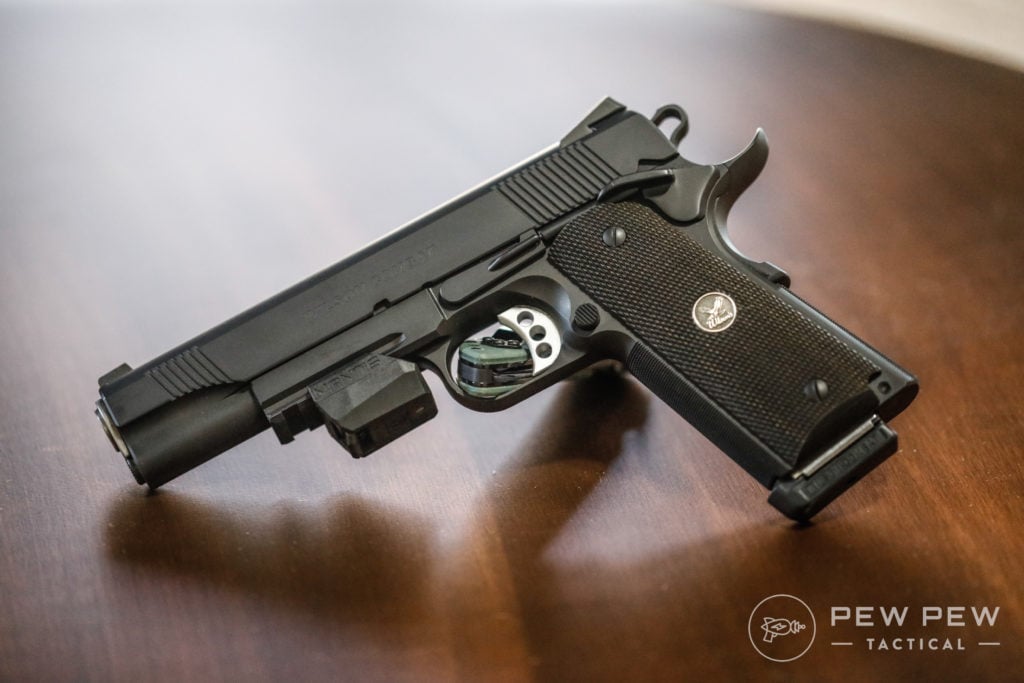
This tiny little block attaches to the accessory rail on your rifle, pistol, or shotgun to provide real-time information regarding everything from trigger pull to draw.
It’s a powerful tool gathering data to diagnose issues and track improvement. You can see exactly what you’re doing wrong — and then fix it.
The information feeds back to your Android or Apple device via the Mantis app and keeps a progress journal for you.
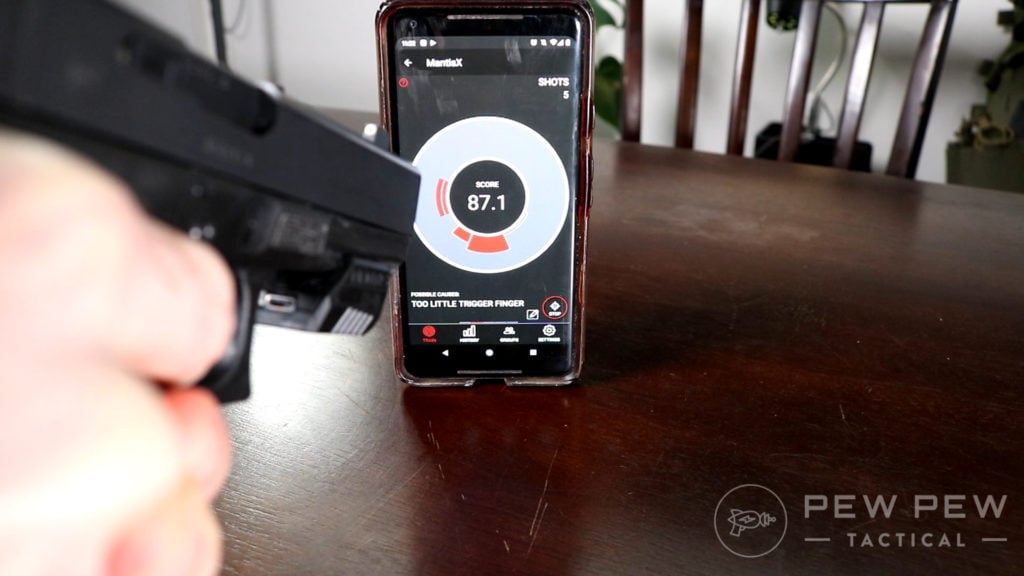
Don’t know where to start? That’s alright because Mantis provides lessons in the app.
I love my Mantis X (the predecessor to the Mantis X2 and X3), and the information it provides is second to none. It’s a ton of data, and I could probably write 2,000 words just on the information it spits out.
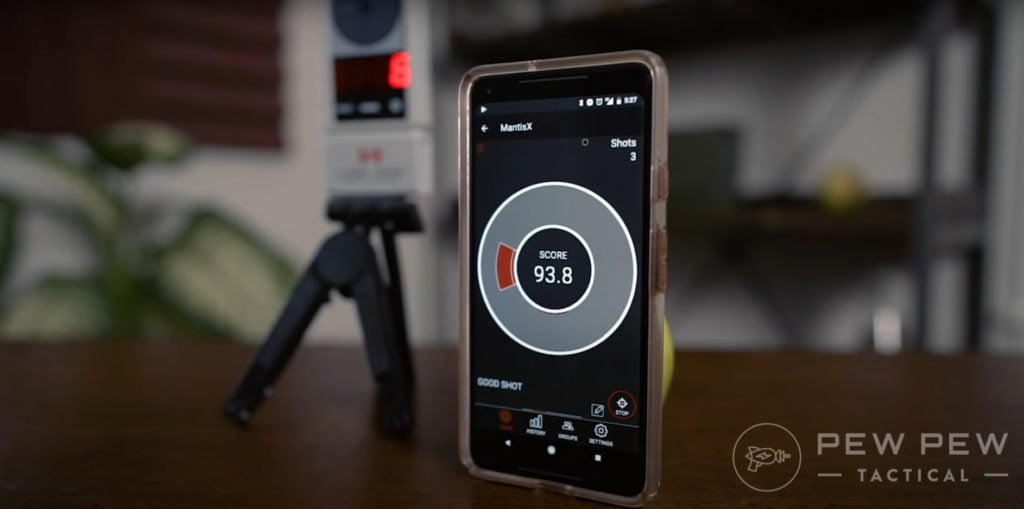
The biggest downside is that you can’t use it without an accessory rail, so revolvers and older-style firearms might be out of luck. The X2 version also doesn’t work with live fire.
The new Mantis X3 app is more expensive, but it’s also compatible with live fire and has some clever new features. You have options!
Read much, much more in our original Mantis X review.
2. A-Zoom Snap Caps – Best Budget
Prices accurate at time of writing
Prices accurate at time of writing
-
25% off all OAKLEY products - OAKLEY25
Copied! Visit Merchant
Pros
- Affordable
- Many cartridge options
- Useful for live-fire drills, too
Cons
- Cheap ones wear out
Specs
- Universal: Cartridge-specific
- App Available: No
- Live-Fire Compatible: Yes
A-Zoom Snap Caps are a must-have training aid. They work for a wide variety of dry and live training functions. Personally, I don’t know how I’d practice malfunction drills safely without them.
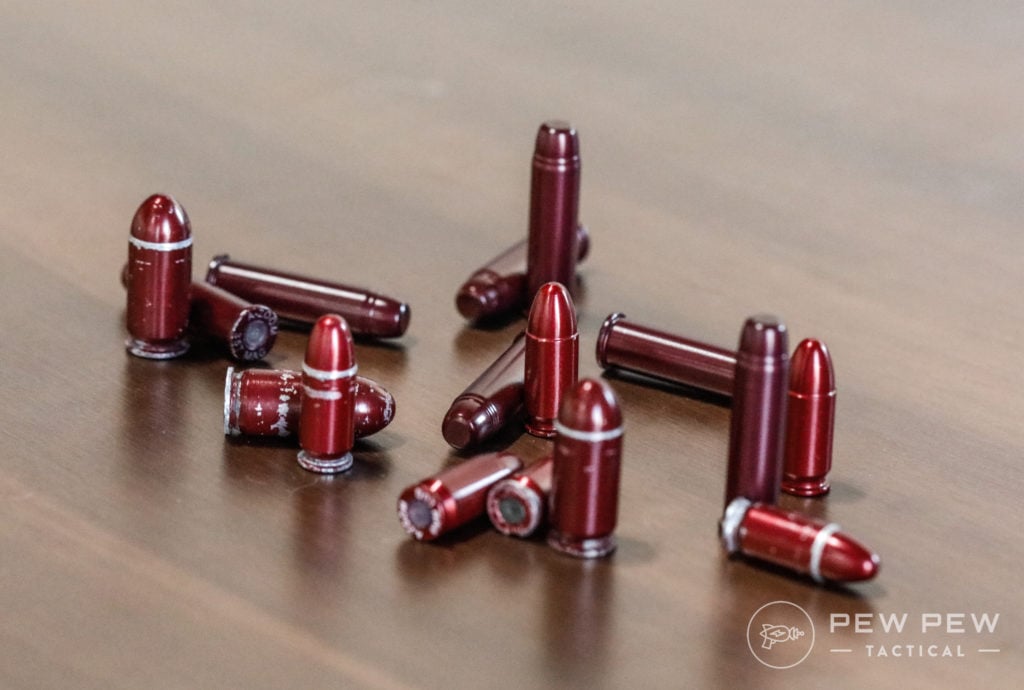
Dummy rounds are super helpful for beginners. You can safely practice the basic motions of loading, unloading, and press-checking without introducing live ammo to the firearm.
If you’re worried about damaging your firearm by dry firing, these Snap Caps have rubber in place of a primer to give your firing pin a safe place to land.
You can also use dummy rounds to create complicated jams to fix with remedial action. Nobody is too experienced for Snap Caps!
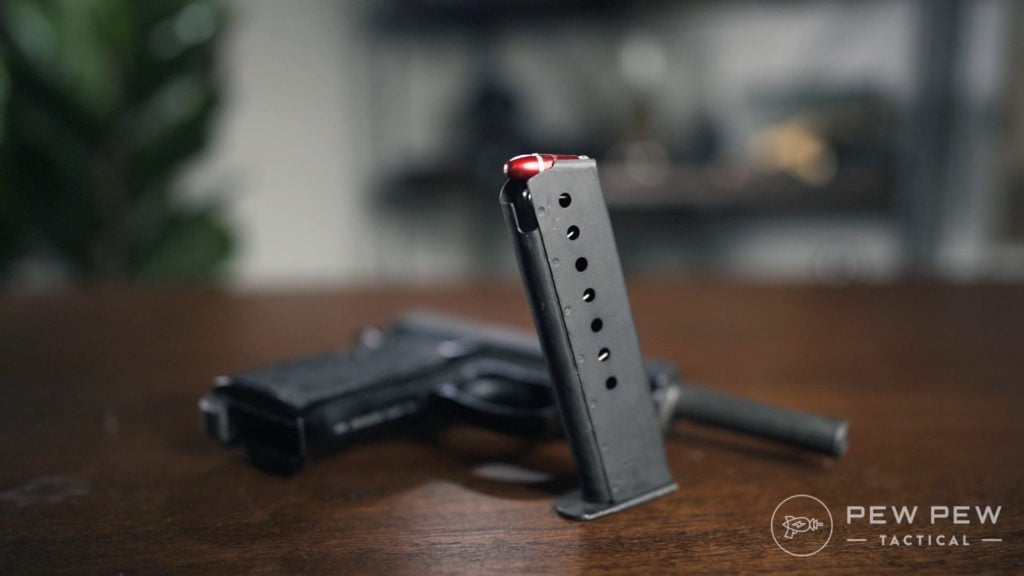
Do you typically shoot pistols low left (or low right, if you’re left-handed)? Snap Caps are the best way to expose a flinch. Next time you’re at the range, have a friend sneak one into a magazine of live rounds for you and watch what happens when you get to it. Whoops!
Need some more suggestions or a different caliber? Check out our article on the Best Dummy Rounds.
3. SG Timer GO – Best Shot Timer
Prices accurate at time of writing
Prices accurate at time of writing
-
25% off all OAKLEY products - OAKLEY25
Copied! Visit Merchant
Pros
- Recognizes dry fire!
- Pair it with the Drills app for even more resources
- Customizable profiles for all your firearms
Cons
- Learning curve
Specs
- Universal: Yes
- App Available: Yes (Drills)
- Live-Fire Compatible: Yes
If you forced me to choose one specific training tool, it would be a shot timer. Shot timers rule!
You can use any shot timer for dry fire by setting a par time and trying to beat it. The SG Timer GO takes training to a whole new level, though.
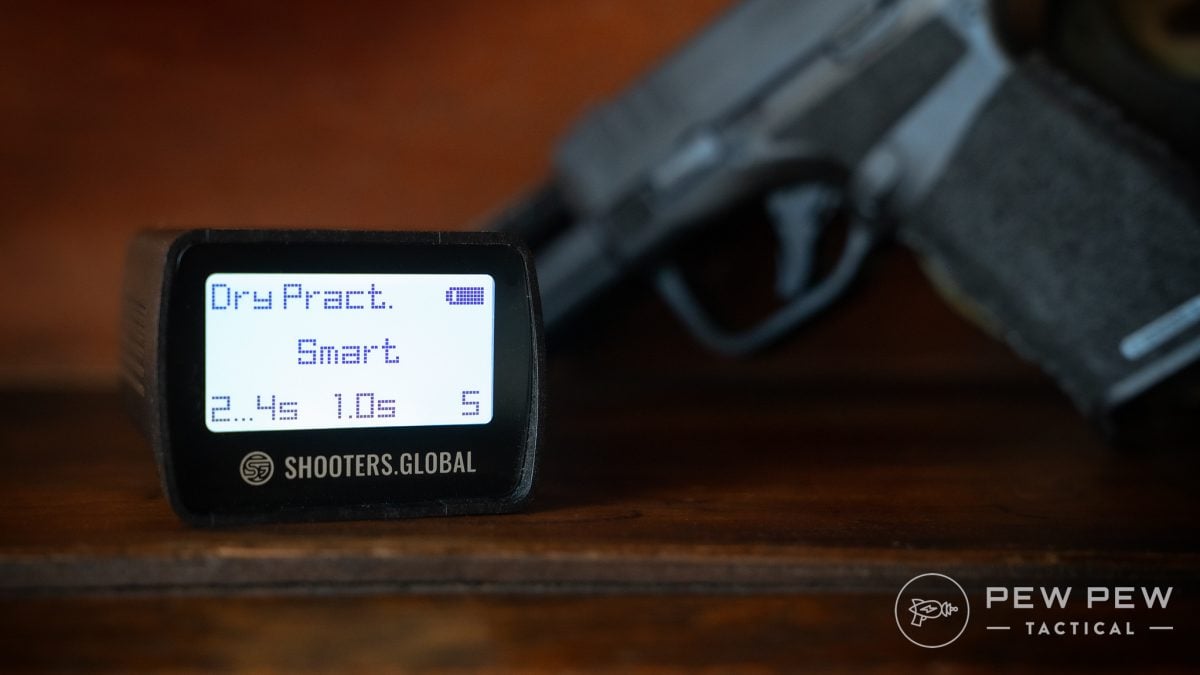
SG lets you program the Timer GO’s sensitivity so it will pick up the quiet “click” of dry firing. Pair it with the app to easily set up strings of fire with prep time built in to reset the trigger if you need to.
Oh, and you can control the buzzer volume so it doesn’t make your ears ring and freak out the pets when you use it in the house.
This unique capability lets you practice reaction time, trigger discipline, drawing, and engaging multiple targets (if you have some of our other picks to reset the trigger), all in the comfort of your own home.
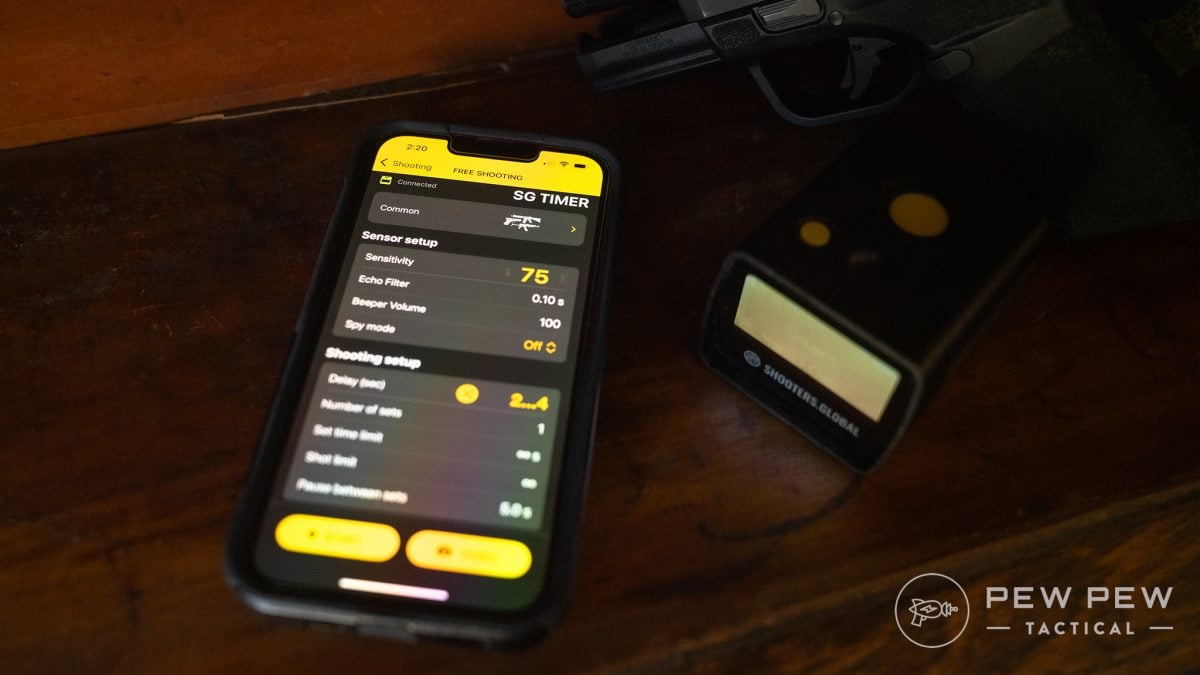
Of course, it also works with live ammunition at the range. There, you can switch to shooting mode and set up custom profiles for specific firearms, specific cartridges, and suppressed shooting. You’re in total control.
The SG Timer GO is genuinely a game changer if you’re serious about getting better as a shooter.
4. Mantis Blackbeard – Best AR-15
-
25% off all OAKLEY products - OAKLEY25
Copied! Visit Merchant
Pros
- Improves your shooting rapidly
- Saves ammo
- Makes dry fire way more fun
Cons
- Doesn't simulate reloads or malfunctions
Specs
- Universal: AR-15 only
- App Available: Yes (Mantis Laser Academy)
- Live-Fire Compatible: No
Yep, another Mantis. But guess what? They are the dry-fire people, plain and simple.
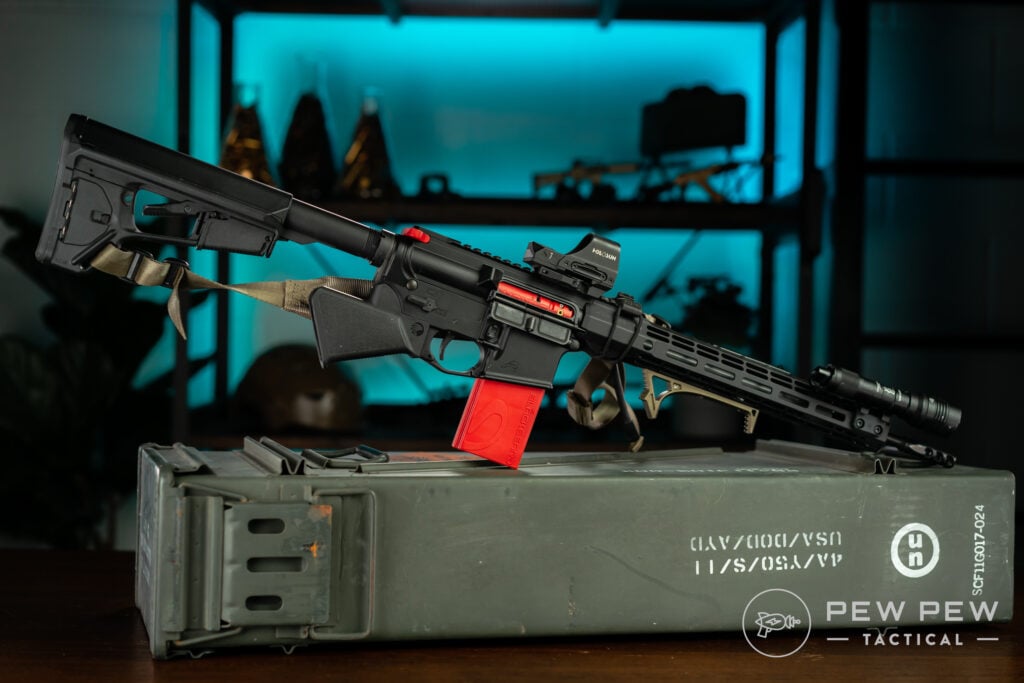
One of the most revolutionary products to date is the Mantis Blackbeard, a dry-fire laser system unlike any other. It drops into your AR-15 in place of the bolt carrier group and magazine.
When you pull the trigger, the Blackbeard bolt fires a laser and automatically resets your trigger. This allows for semi-auto dry fire practice — no need to constantly rack the gun.
This saves time and avoids some really, really terrible habits. Don’t condition yourself to lift your face from the stock and reach for the charging handle after every shot!
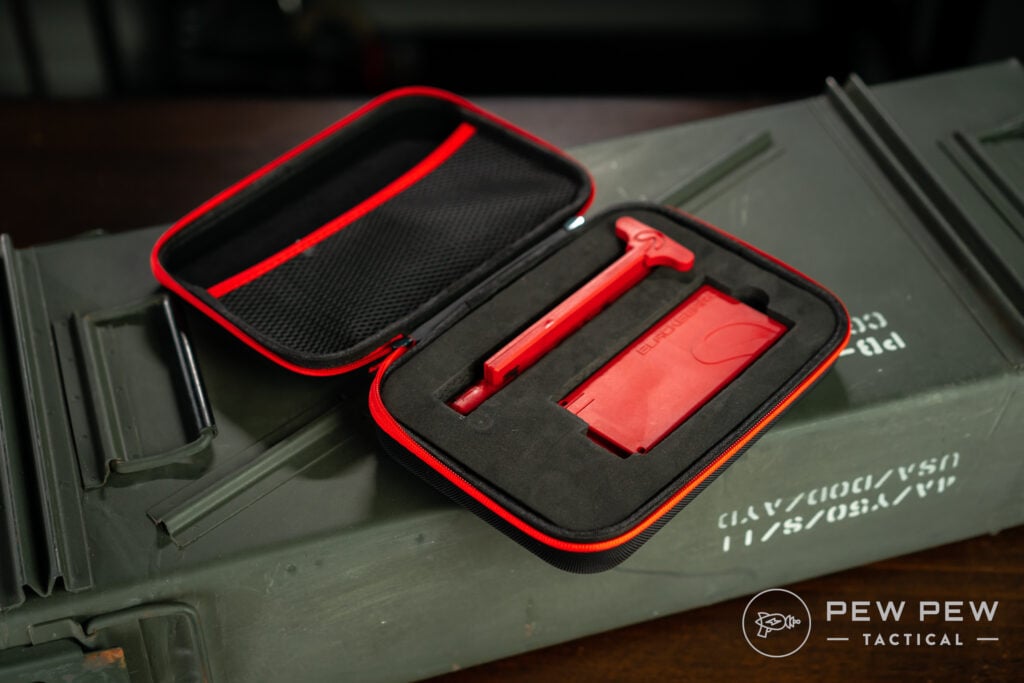
I use this system for more than just training my trigger press. I run the VTAC 1-5 drill, failure to stop drills, and many, many more. It’s deeply satisfying, very effective, and tons of fun.
Take a peek at our hands-on Mantis Blackbeard review!
5. Mantis Laser Academy – Best Multi-User
-
25% off all OAKLEY products - OAKLEY25
Copied! Visit Merchant
Pros
- Easy to set up and use
- Wide array of targets
- Also works with SIRT systems
Cons
- Occasional false positive hits
Specs
- Universal: Cartridge-specific
- App Available: Yes (Mantis Laser Academy)
- Live-Fire Compatible:
Hang on, we’ve got one more Mantis system for you! The Mantis Laser Academy is an excellent way to train by yourself, with others, and with non-Mantis laser systems.
There are lots of Android and iOS apps that pair with a laser cartridge, but the Mantis Laser Academy is by far the best. It’s a complete system of targets, a tripod, a laser cartridge, and several means to hold up the included targets.
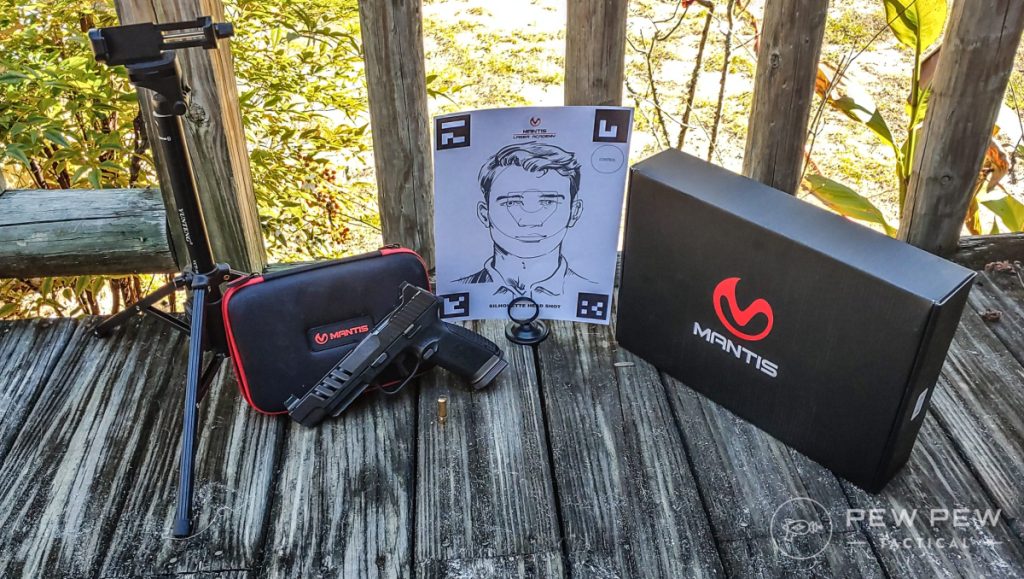
The targets come in both standard and reduced sizes. The Mantis app uses your phone’s camera to read the targets and provide a numerical score based on where your hits are landing.
The targets are quite varied, and you can print new targets if you need them. One of the FBI Q-style targets stays pinned to my wall permanently.
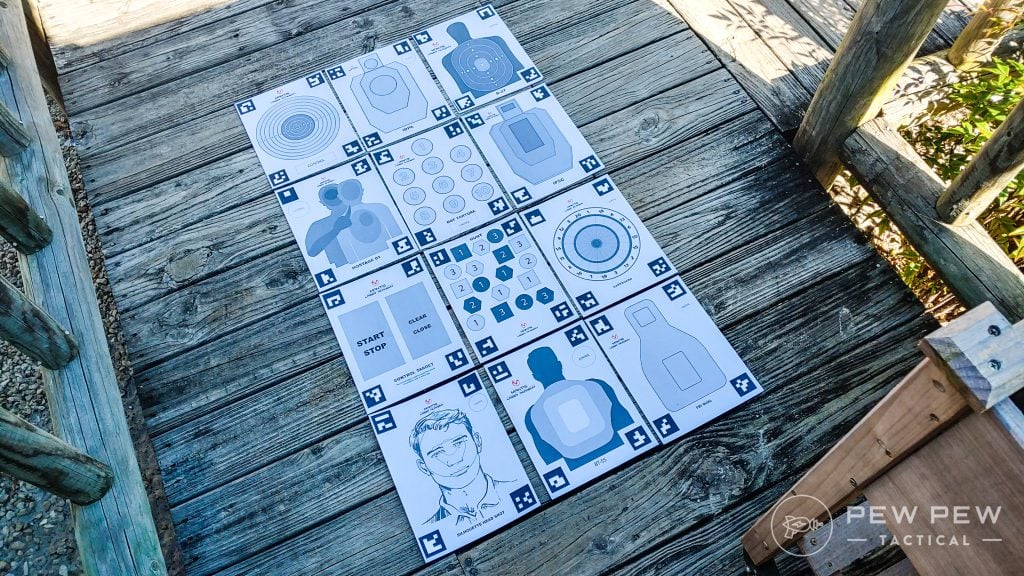
The app has tons of different modes that address specific handgun training techniques. Practice drawing, reloading, clearing malfunctions, and more.
It even has a multiplayer duel function where two shooters attempt to get higher scores and race to land several shots on target. It’s not only a good bit of training, but it’s fun and entertaining.
Check out our full review of the Mantis Laser Academy to see what I mean!
6. TRT Tap Rack Dry Fire Devices – Best Magazine Insert
-
25% off all OAKLEY products - OAKLEY25
Copied! Visit Merchant
Pros
- Very affordable
- Multiple cartridge options
- High-visibility colors
Cons
- Not universal
Specs
- Universal: Cartridge-specific
- App Available: No
- Live-Fire Compatible: No
Want to snap in more effectively with your existing magazines?
For less than $10, you can have three Rogers TRT inserts for your pistol or AR-15. These little devices fit inside your magazines and defeat the last round bolt hold-open (LRBHO) device.
In my opinion, that offers two distinct advantages.
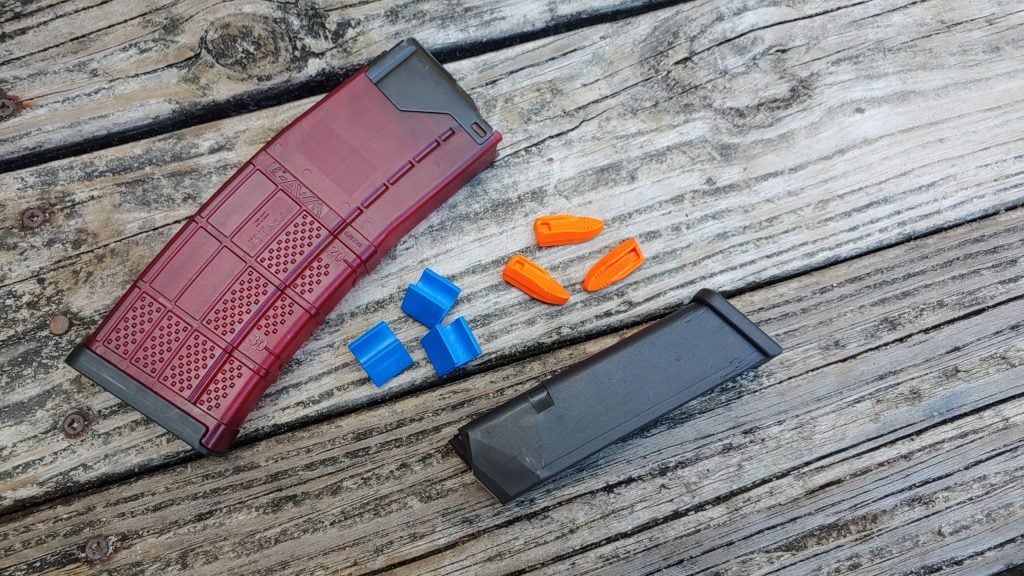
First, they ensure your magazine cannot be loaded during dry fire training. Second, you can execute reloads on the fly without constantly dealing with ejecting dummy rounds or manipulating the bolt/slide release.
These are also handy when practicing malfunction drills. You can induce a malfunction with a dummy round and execute a proper fix without having to worry about the LRBHO.
7. DryFire Mag – Best Magazine
Prices accurate at time of writing
Prices accurate at time of writing
-
25% off all OAKLEY products - OAKLEY25
Copied! Visit Merchant
Pros
- Saves time
- Available for several pistols
- Stackable with other products
Cons
- Alters trigger pull
Specs
- Universal: Firearm-specific
- App Available: No
- Live-Fire Compatible: No
When you dry fire with a striker-fired pistol, you likely get quite sick of manipulating the slide to recock the pistol between shots. It’s an atypical action that gets really old and build a bad habit of breaking your grip after each shot.
DryFire Mag solves that problem. It replaces your magazine and simulates a trigger pull without the need to ever reset your firing pin.
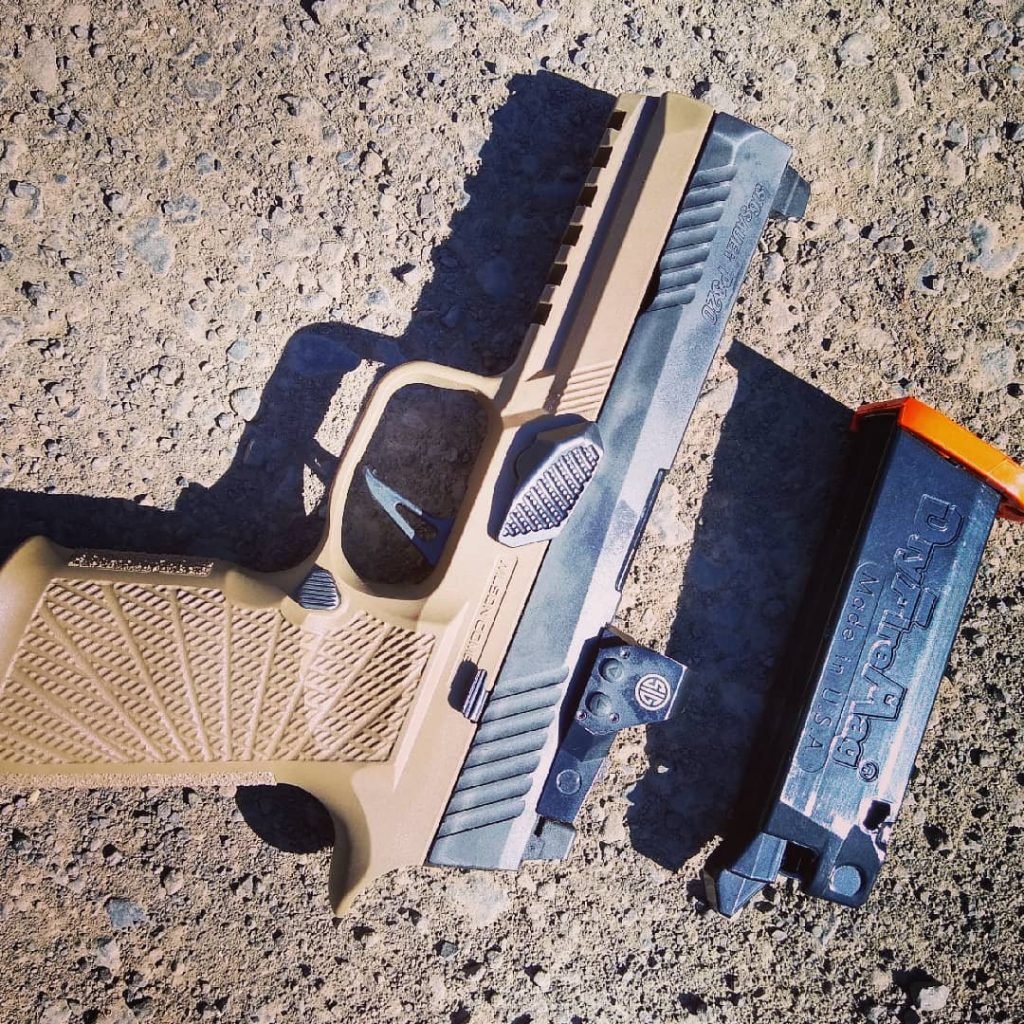
DFMs are made for Glock, Palmetto State Armory Dagger, Sig Sauer P320, Smith & Wesson M&P, and Springfield XD pistols. Installation is nothing more than dropping that magazine in.
You can pull the trigger over and over, and it will simulate the trigger pull of your gun. No more racking the weapon after every shot.
The DFM is great for running drills like el presidente, failure to stop, or 5-5-5 without ammo. It’s an excellent tool, especially when combined with a Mantis system.
8. SIRT – Best Training Pistol
Prices accurate at time of writing
Prices accurate at time of writing
-
25% off all OAKLEY products - OAKLEY25
Copied! Visit Merchant
Pros
- Safely practice combined combative
- Realistic manual of arms
- Multiple models available
Cons
- Expensive
Specs
- Universal: Standalone device
- App Available: Yes (various laser-based systems)
- Live-Fire Compatible: No
The SIRT Pistol isn’t an attachment for your existing pistol, it’s a non-firing replica that works all on its own. There’s also an AR-15 laser bolt that drops into your rifle.
These systems weigh close to the same as a real firearm, and use an integrated laser to show where shots would land if you were using real ammunition.
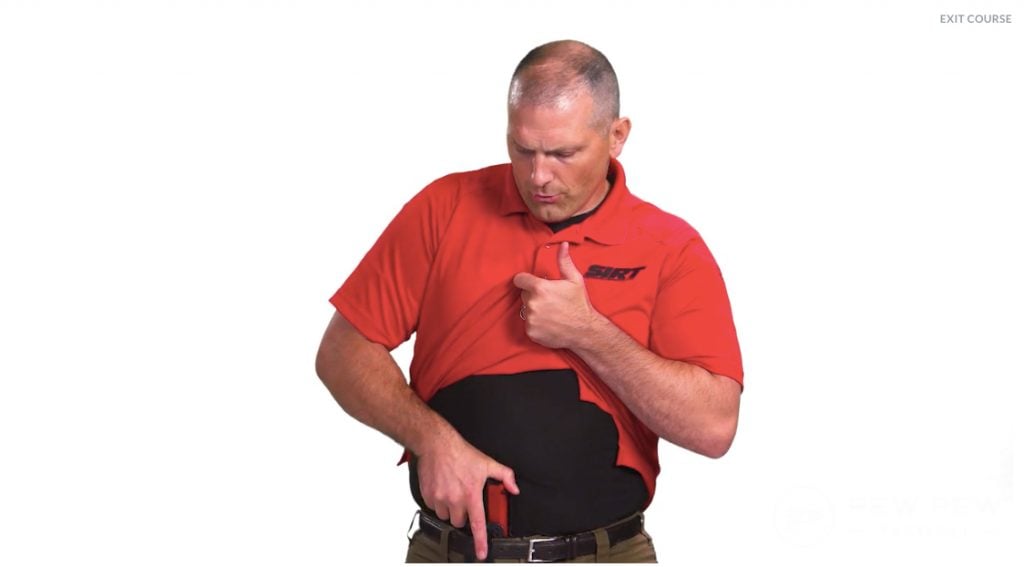
Trigger pull on the SIRT is lighter than most handguns but, for learning the basics and having a 100% always safe option, it’s a solid contender.
You can even purchase extra SIRT magazines that replicate the real weight of loaded magazines for training drills.
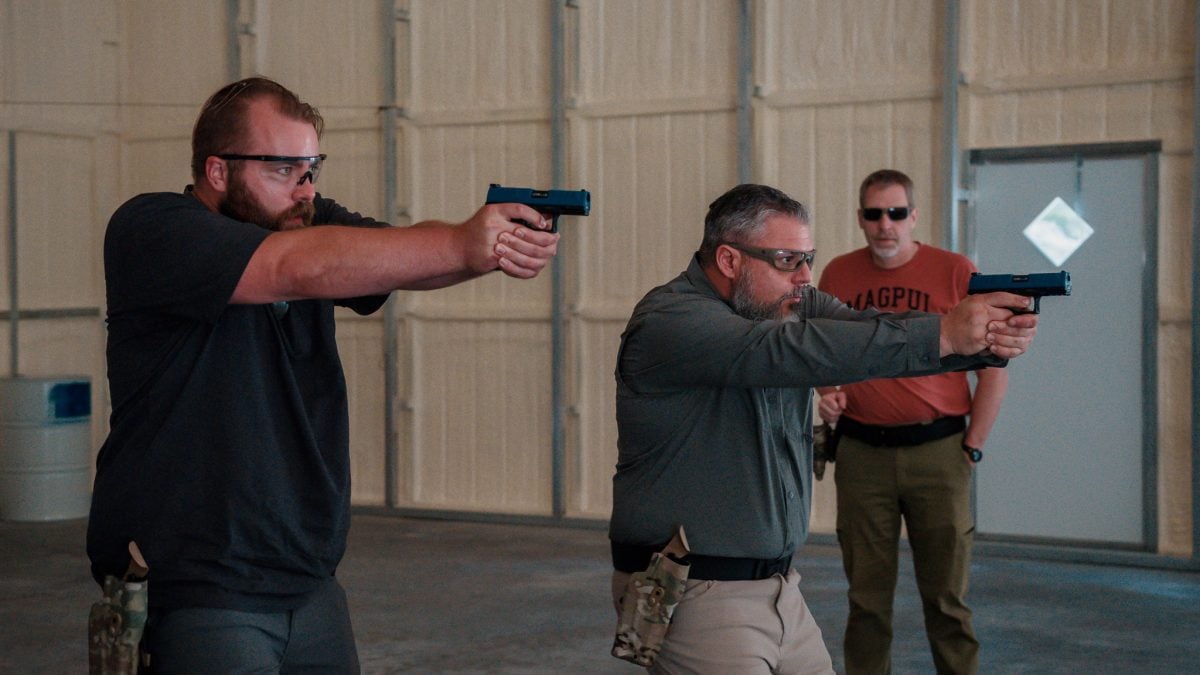
Since these aren’t real guns, they’re great for practicing combined combative techniques. Have you ever tried grappling until someone gives the command to draw your training pistol? It’ll have you reevaluating a few things in a hurry.
SIRT guns give you visual feedback and will function with most of the laser systems we recommend. They’re expensive, but we think they’re worth it.
9. Range Buddy Pro – Best Free App
Prices accurate at time of writing
Prices accurate at time of writing
-
25% off all OAKLEY products - OAKLEY25
Copied! Visit Merchant
Pros
- It's free!
- Huge library of drills
- Virtual instructors
Cons
- No feedback
Specs
- Universal: Yes
- App Available: Yes (Range Buddy Pro)
- Live-Fire Compatible: Yes
The Range Buddy app is designed around training in general, including live fire range time.
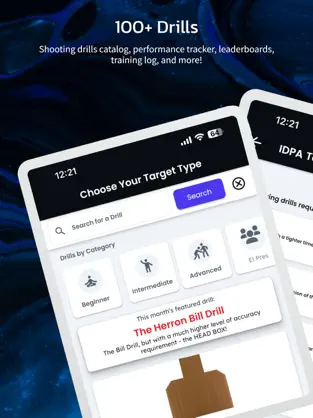
This free app (donations are accepted) provides you with a ton of different drills and courses of fire to practice. It breaks down each drill step-by-step so you don’t have to reinvent the wheel.
The app also provides a new feature that can issue commands. You’ll need a corresponding target with shapes, colors, or numbers, but it can call the commands out to you for a more engaging experience.
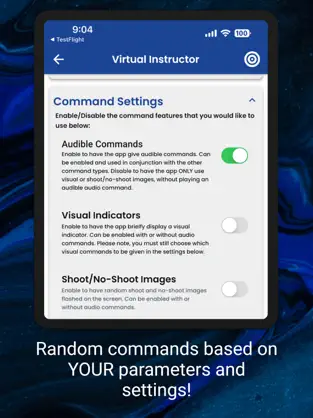
This makes dry fire a little more interesting and dynamic. The Range Buddy Pro app can walk you through dry fire drills that you can run run live later. It is simple but very effective, easy to use, and can be paired with numerous other dry fire gadgets and gizmos.
And it’s free!
How to Pick the Best Dry Fire Training Aids
There are some incredible training tools on this list. With a little bit of practice each day, you can progress from newbie to marksman before you know it.
Free Dry Fire Techniques
The coin trick is a simple technique you can do to evaluate your trigger control.
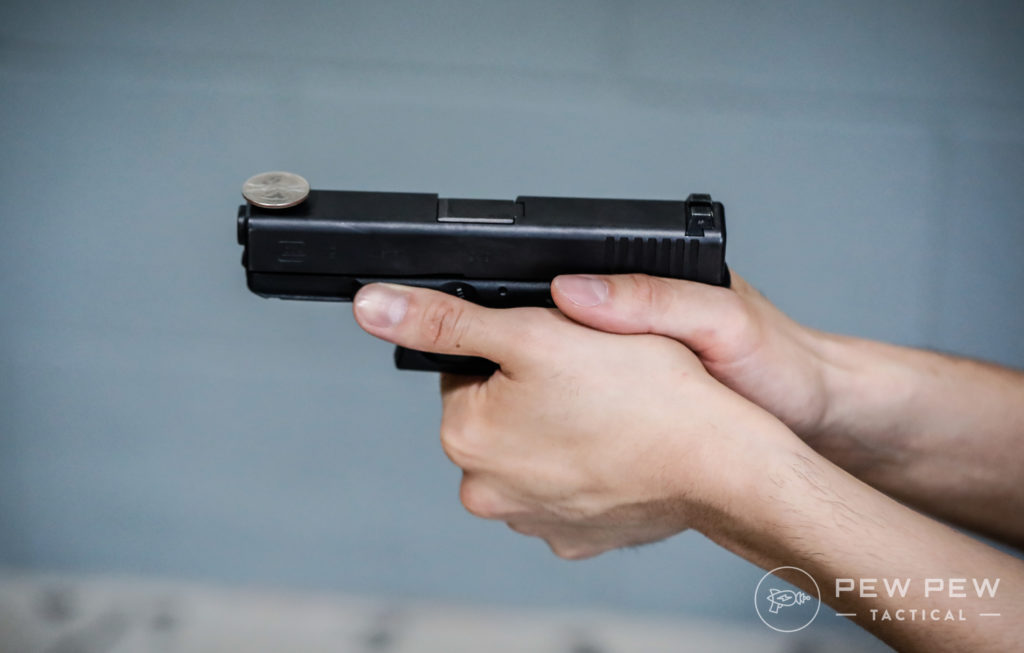
Balance the coin on the front sight. As the coin rests on the sight, practice your grip control. Smoothly press the trigger until you get an audible click. Is the coin still there?
Any error will cause the quarter to fall, which will reveal unnecessary motion in your trigger press. If you were at the range, that would have been a miss — good thing you didn’t have to pay for ammo to find out!
You can also practice your open- or concealed-carry draw during dry fire practice.
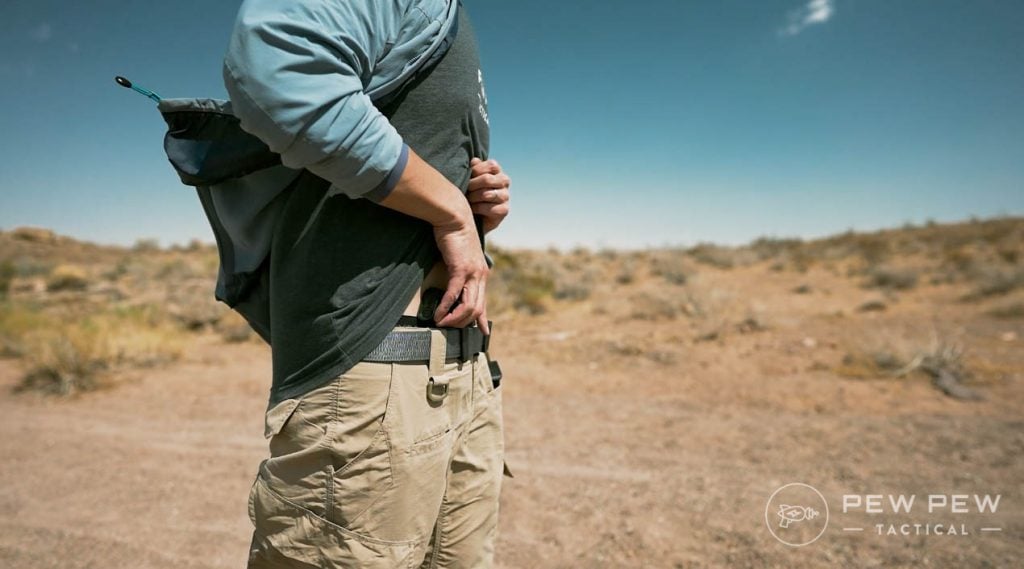
Start slow. Focus on proper grip, drawing, and aiming. Add speed and pressure in the form of a timer as your progress.
You don’t have a Hollywood pistol that never runs out of ammo, do you? Then you’d better practice reloads while you’re at it.
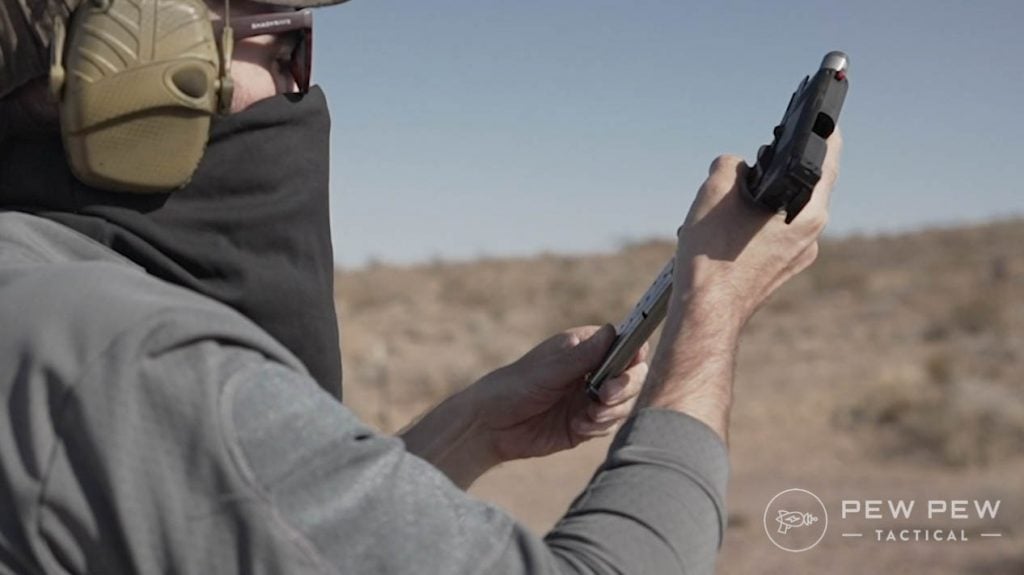
Basic Dry Fire Training Aids
There are some training tools that every shooter should own.
One is a set of snap caps or dummy rounds. These can reduce wear on your firearm if you’re concerned about that.
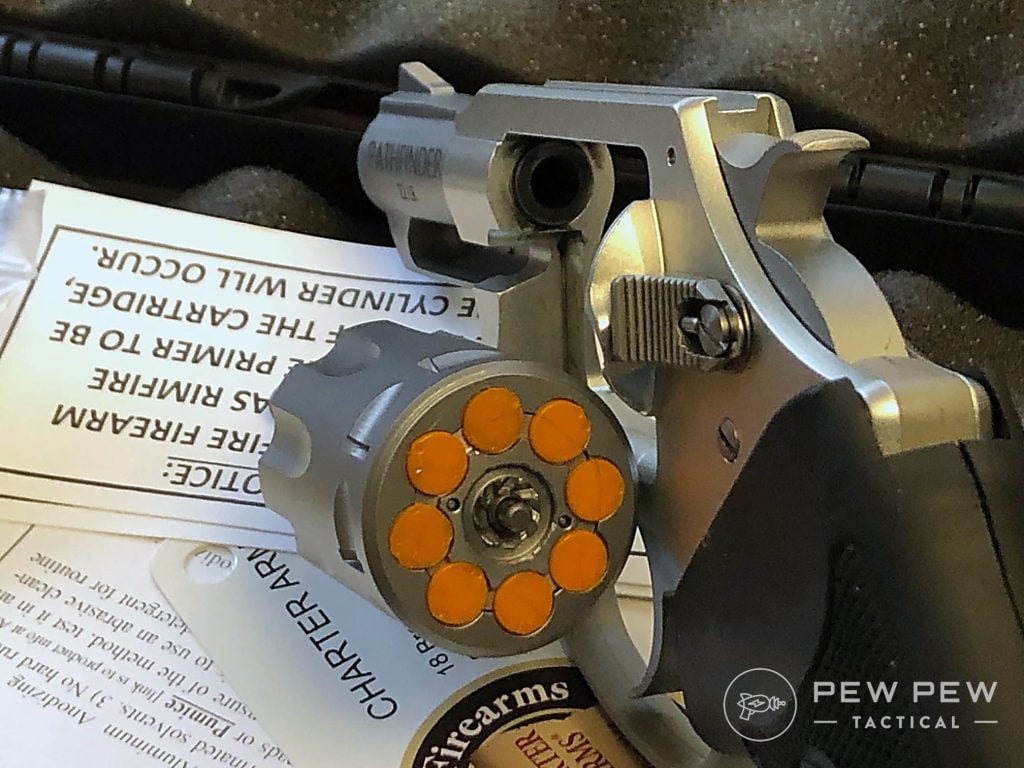
They can also reveal an undiagnosed flinch. When you’re training with live ammo at the range, have a friend load a magazine for you that includes one snap cap. Since you don’t know when the fake round is coming, your flinch will be obvious when there’s no recoil to cover it up.
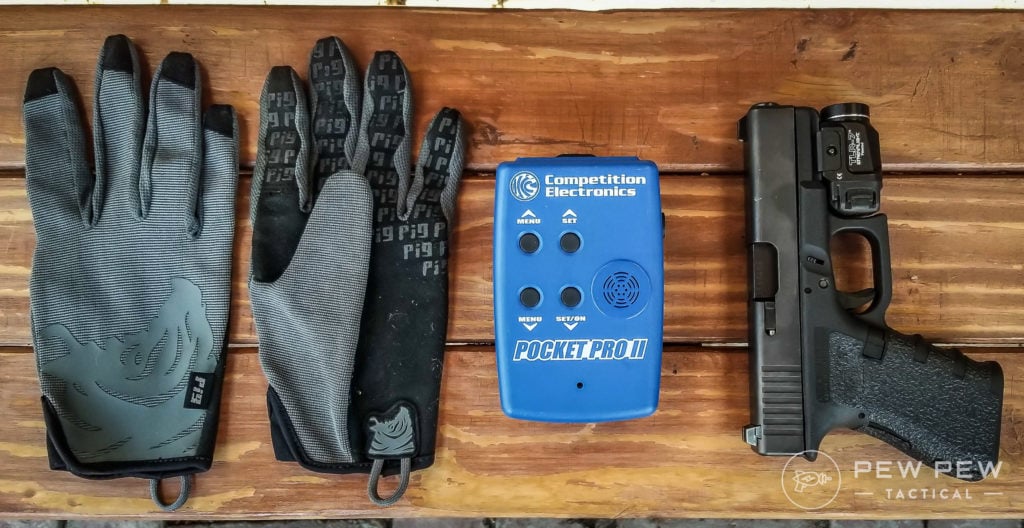
Next, buy a shot timer. Whether you’re dry-firing or shooting at the range, a timer will push you to be better and provide totally honest feedback. Don’t get hung up on individual times; watch averages and trends over time to check your progress.
Advanced Dry Fire Systems
Are you ready to fully commit to becoming a good shot? It’s time for more sophisticated tools.
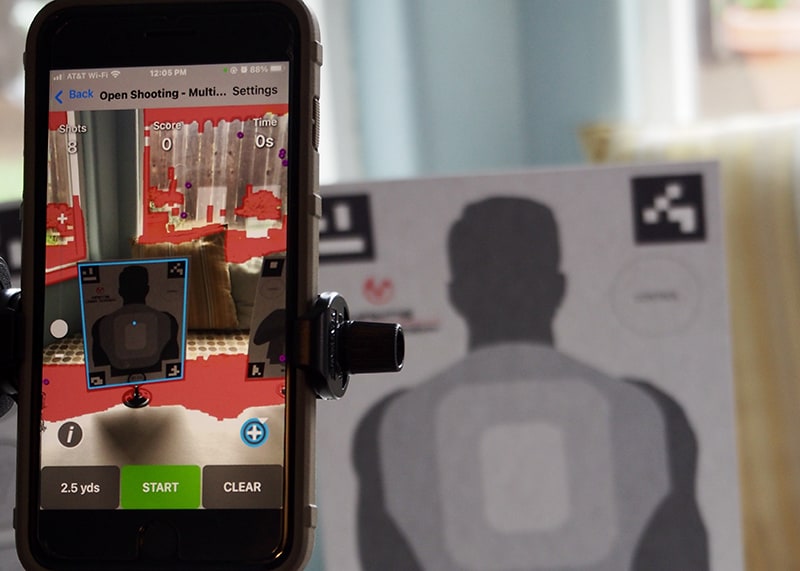
Something like the Mantis X will provide more efficient training, instant feedback, and real data that you can evaluate to fine-tune your skills.
Yes, these cost more that our other recommendations, but they’re a financial investment that you’ll be grateful for the next time you send live rounds into the A-zone instead of peppering the berm, wondering what you’re doing wrong, and shuffling back to the car in disappointment.
Why Trust Pew Pew Tactical
This article comes to you from Travis Pike. Travis is an NRA-certified instructor and concealed carry trainer out of Florida. He served as a Marine infantryman in his prior life, so he has plenty of time behind guns. Between instructing, serving in the military, and testing and evaluating firearms over the years, Travis has come to learn a thing or two about training and being trained. He’s a huge proponent of dry fire, too!
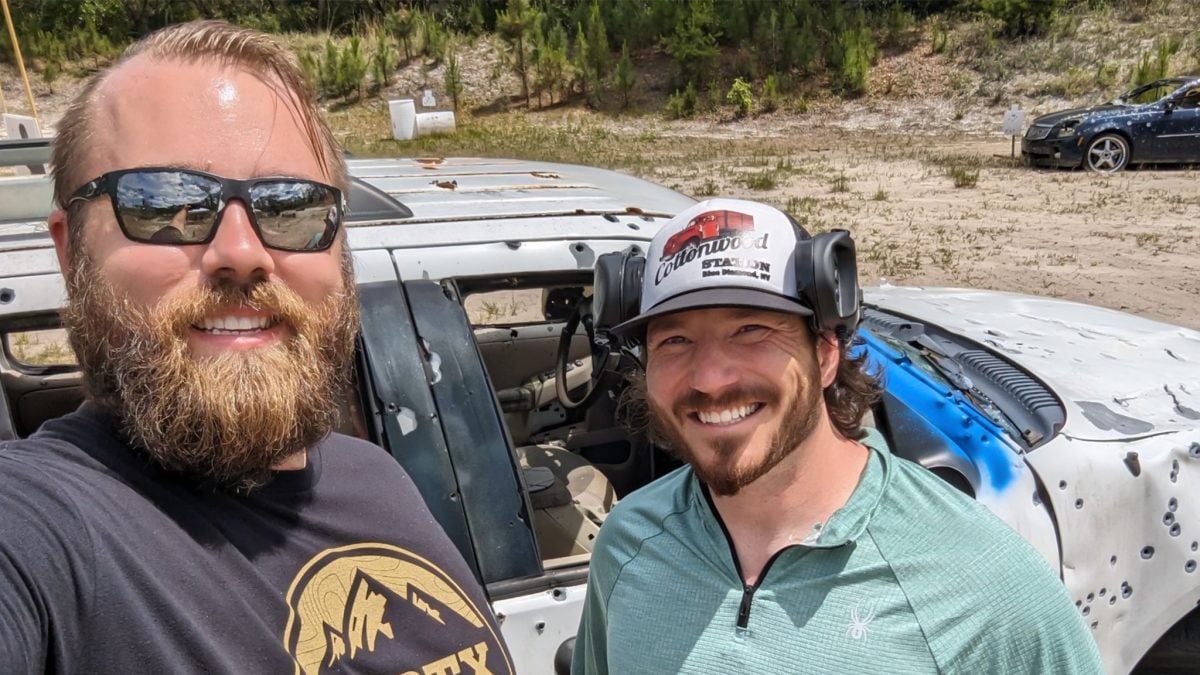
Editing this article is Scott Murdock. Scott is a Marine Corps veteran who competed and qualified as a rifle and pistol expert while in service. In addition to shooting, Scott has written for a variety of publications, testing, researching, and evaluating guns and gear. He brings that knowledge and skillset to this article, editing and fact-checking for accuracy.
Editor-in-Chief Jacki Billings runs our experienced team of reviewers. She is a National Rifle Association Basic Pistol Instructor as well as a member of the Society of Professional Journalists, ACES: Society for Editing, and the Professional Outdoor Media Association. Jacki has a bachelor’s degree in journalism and has worked as a media professional for close to 20 years, specializing in gun media for almost 10 years. With 2,000+ articles to her name, she uses her professional journalism and editing experience to set testing protocols and editorial standards for Pew Pew Tactical.
Final Thoughts
While dry fire training can’t fully replace live fire training, it certainly complements it.
Becoming a dry-fire pro takes time, patience, and the ability to really keep after it. A few minutes a day can dramatically improve your skills without hitting the range.
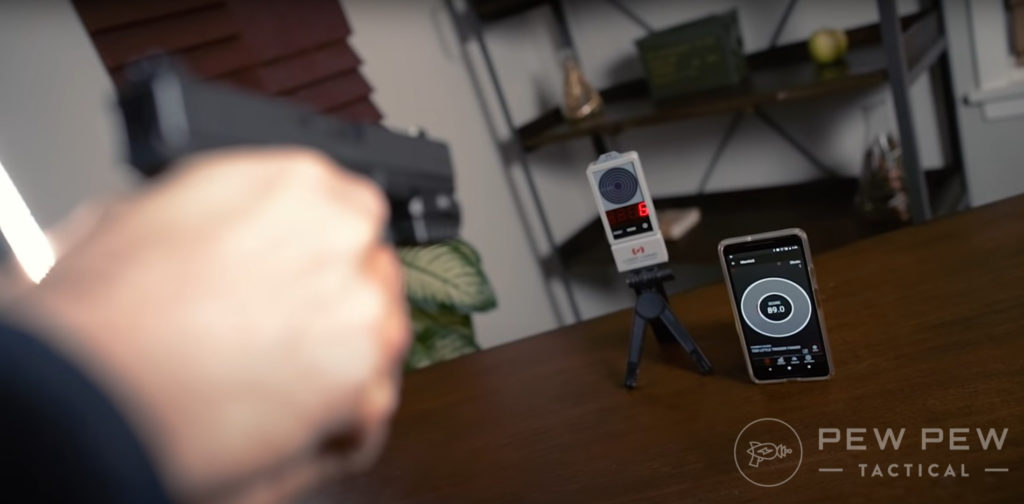
And adding a few gadgets or gizmos makes dry fire not only more entertaining, but more dynamic and engaging while turning 15 minutes of so-so practice into incredibly efficient training.
Have more questions about safe and effective training? Let us know in the comments below! And check out our online Beginner Handgun Course, Gun Noob to Gun Slinger. We cover the basics you need to become a crack shot.
Latest Updates
February 2025: Removed the Pocket Pro II shot timer. Added the SG Timer GO. Added a comparison chart and updated supporting content.

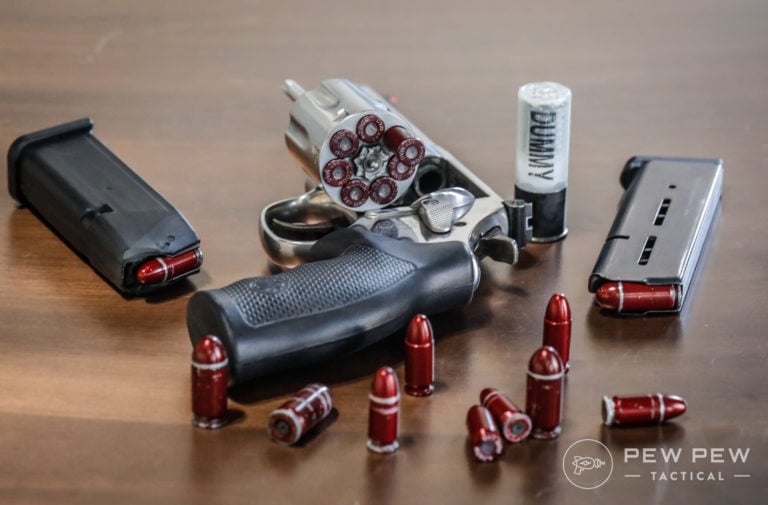
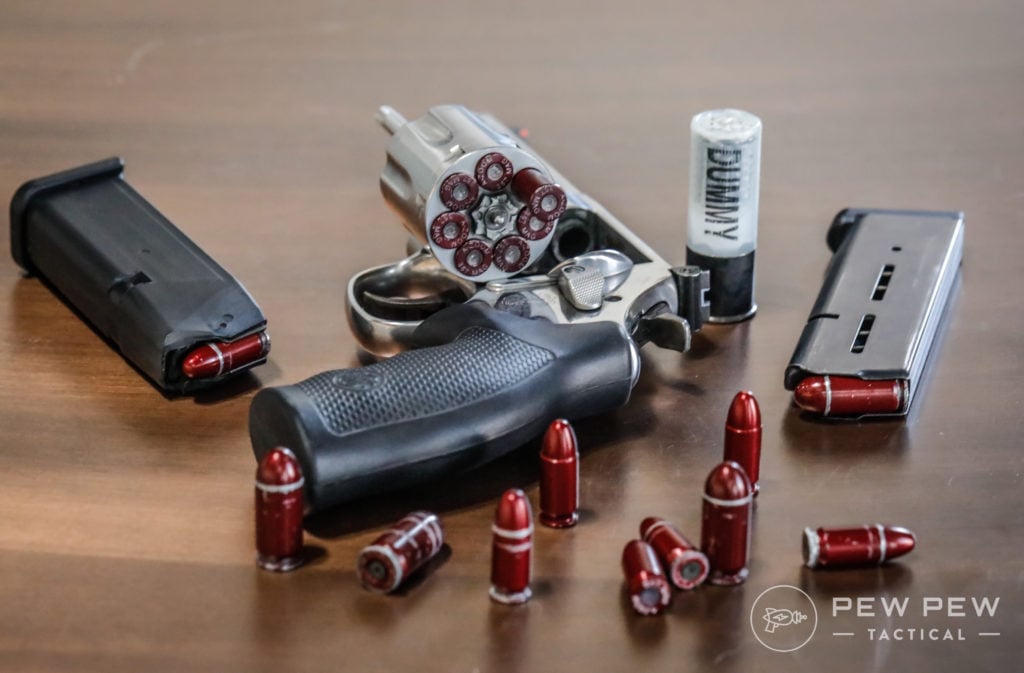









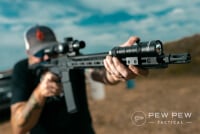

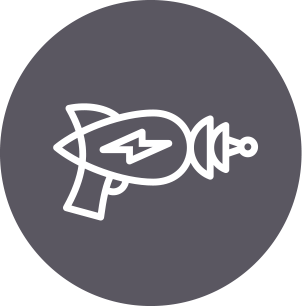




52 Leave a Reply
Hi Travis
Have you an opinion on Strikeman dry-training systems?
Thanks for your informative articles!
Russ
Very good information! Thank you
I use a G-Sight laser cartridge for my dry fire sessions. While it is not as "sophisticated" as the Mantle systems, it does give a good visual indication of one's accuracy. It has a phone app to record the laser strikes, so one can have a history of performance.
Anyone else having issues downloading the Range Buddy Pro app? I tried the link, the App Store (doesn’t even show up in a search), their website… I just get a white screen.
I just downloaded to my iPad, no problem
Yep, after your reply I tried again without issue. Go figure.
Thanks for the great article . I’ve been using the Mantis laser Academy for about a year and it has helped a ton, especially trigger control. They continue to improve the app making it even better. Dry fire has also improved my draw and fire accuracy using the different modes of the app. You can purchase the laser cartridge for $40 and print all the targets from their website if you want to go Dutch. Enough of the app is free to use for what I do.
The only firearm I own or want to own is a revolver, my Smith & Wesson 686 Plus .357 with a 5 inch barrel. Is there any kind of systematic dry fire practice that would benefit me?
Have a look at G-Sight. They may have a laser cartridge in .357.
I compete in both IDPA and USPSA and the best system for realistic (and fun) dryfire that I have used is the LASR Classic system with Camera combined with the Coolfire System with IR laser. I use reduced sized targets (1/3rd, 1/4 and 1/6th) and can set up stage scenarios and classifiers. The Coolfire gives you decent recoil and resets your trigger and With the
camera and IR laser you can see your hits on a laptop screen. You also get time to first draw, split times, transition times and it can also calculate hit factors. This is by far the best dryfire combination for competition shooters.
a Link to your recommendation, thx
Try lasrapp dot com
The last time I looked at Cool Fire, they supported a very limited set of pistol brands.
Has that changed?
They have most of the popular pistols used in competition. I have one for my Sig P320 and CZ SP01.
Have you guys tested the iTarget Cube system?
I use this all the time for dry firing. My aim is much improved now.
Before the days of snap caps, we made our own out of a spent casing, de-capped of the spent primer, and a small piece of rubber inner tube. We'd use a leather punch (the kind with the 6 different size punches), or a hollow hole punch that would produce these neat little rubber 'rounds' just the right size as a primer. A little glue to hold the rubber circle in the primer pocket and "Tah-Dah" - instant snap cap. Actually if you're inventive enough you can use the same trick to make a 'rim-fire' snap cap out of a 5/8" piece of metal rod (old cleaning rod - turned to .223 dia) and a rubber round of .272 dia. Getting these rubber rounds to stay put is a pain - but a small hole drilled through the center and into the rod, then gluing a piece of a sewing pin works. As they say - Necessity is the Mother of invention, but these days, the full plastic snap caps are way mo-cool and feed like a live round if you're into working the action as with the mag changing drills.
I strongly recommend you check out the CoolFire training system.
What would be the better choice, TRT Device or a Dry Fire Mag? I would probably also get dummy rounds. I have a Sig M17 (9mm)
Hey Travis,
I’m a new shooter and am working with a senior tactical trainer I have been shooting for about 6 months now and we just training today. I find all your articles really information and easy to understand thanks for your opinions on all things guns.
Brooke
Instead of snap caps, a small silicone 0-ring big enough to wedge in the back of the slide over the firing can work for some guns to prevent the hammer from needlessly hitting the firing pin. Next steps could be sight re-acquisition during target transitions and even simulating recoil by jerking your wrists / elbows (ammo is expensive!)
Is the Taurus TX22 considered a rim fire and therefore not a candidate for dry fire?
The Russian software of dry fire caught my eye, which works perfectly with such models as SIRT Pistol, but unlike our brands, the price is several times lower. Here is the address link.shooting-soft.com/mtoZCZ
We purchased a laser dry fire system from LaserHIT and am very happy with it!
Back in my USMC days, we always had a "grass week" before range week to help prepare us for rife and pistol qualification day. Grass week was a lot of repetitive dry firing, but it really did help train our muscle memory, teach natural point of aim, breathing rhythm and controlled trigger squeeze.
I also train with the Japanese katana in a martial art called batto-do ... we do a lot of kata with our swords which I view as akin to dry firing. Drawing our blades and moving into a cut then returning the blade (noto) to it's sheath (saya) ... we must demonstrate safe and proficient kata with our swords before we are finally allowed to cut on real targets such as rolled tatami mats or even bamboo. Just like shooting, it's not quite as easy as they make it look in movies. So, yes - I am a big believer in adding dry firing to my firearms training regimen!
My range scores (pistol) increased dramatically after I started dry fire training. I don't do anything fancy I just point my weapon at something like a light switch and work at keeping my sight picture from moving when I fire. Concentrating on just moving my trigger finger alone and keeping the rest of my fingers/hand from moving the gun was the most important thing I ever did to improve my aim, and I did this through the use of dry firing.
P.S. I also bought an airsoft gun that I play/train with inside, and a metal co2 bb gun that cycles like a real semi auto that I play with outside. I think these are fun options for training away from the range (though I believe dry fire to produce the best results)
The coolest and best dry fire trainer I've found is the Coolfire Trainer. Its a replacement barrel for your pistol that holds CO2. So, whenever you fire you get a recoil impulse which is awesome for recoil management. Also comes with an optional built in laser to see where you're hitting. Combine it with a Mantis X and you have a serious training tool my friends!
I have a laser insert for my HKP2000SK and an itarget . If I want to practice at SA trigger pull, I need to rack the slide after every trigger pull. I would like to find a laser trainer that would allow me to do double taps and repetitive shooting with about a 4 lb. trigger pull that wouldn't require me to rack a slide. Any ideas?
Hi
See TheDryFire Mag. Goes great with Mantis X. Check out their site.
Two questions:
Aviators Tactical has its laser training cartridge for $38.75 which is way less
than the ones you recommend. Is that because Aviators Tactical's quality/functionality
is not as good?
If you insert one of these laser cartridges in a 1911 .45 ACP, do you simply
cock the trigger with your thumb each time you "shoot" the laser?
Do you or should you cock the trigger by pulling the slide as well?
You suggested using a chamber flag for safety while conducting dry-fire training. A better product is the the Barrel Bloc. A chamber flag keeps the gun out of battery and therefore you are unable to operate the trigger. The Barrel Bloc fills the chamber and allows the action to full close, thus keeping the firearm perfectly safe AND allowing you to work that action as you would during live fire training.
Having a hard time finding Laser Lyte targets. Have they gone out of business?
Check out the iTarget. I have enjoyed using mine, plus much cheaper than most options, $107 tax and shipping included. Hopefully Pew Pew will review some day.
Competition shooters know the importance of daily dry fire practice at home, and how it translates to live fire shooting in the field. It improves technique which is 90% of the shot. Using a laser ammo/target combination helps tremendously. Just make sure the laser ammo can easily be inserted and removed from your weapon. Within your own personal limitation issues, practice your shooting stances daily committing everything to muscle memory. If you use a shooting stick, include it in your practice. However, don't forget to practice your freestyle shooting stances because, if you are a hunter, there will instances when you will have to shoot an animal freestyle. Shooting is one of those skills that you must use it or lose it, so daily practice is important. If you anticipate shooting while wearing a backpack, practice wearing your backpack. Make your practice as realistic as possible. If you anticipate shooting around corners and vegetation, practice shooting in these environments. Dry practice will make a world of difference in the field.
need to include the Cool Fire trainer in this article. The absolute best dry-fire tool I own
Good article Travis. Pew Pew Tactical is my go-to sight for lots of good gun and shooting information. I was wondering if you have used the G-sight system. It seems to be a good inexpensive way to train.
Like David Phillips, I like to re-read Pew Pew articles for solid, accurate information with a sense of safety and humor rolled into one. Practice and muscle memory is so important. Many folks think you only gain skill going to the range, when you can really gain skill prior to the range making your range time more worth while.
Very good article, and one I've linked to re-read as I go through a medically forced downtime. Just a couple of suggestions. Point out that the chamber safety flag you link is a pack of 6, for the price.
There's also a product called Barrel-Block, that fits into the chamber, protrudes from the barrel, and lets you completely close the slide. It's effectively a chamber safety flag, and snap cap rolled into one. It comes with magazine blocks as well, which let you have a magazine in, and rack the slide without your snap cap flying out & rolling under a sofa.
I haven't read your Mantis X review yet, but have learned that they sell magazine floor plates for the system if your pistol doesn't have a rail.
Finally, you rite gud for a jarhead :-)
Informative article. Excited to try my recently purchased Mantis X. Question: do you have recommendations for low cost outdoor target stands?
I use paper targets and dryfireonline.com
On a piece of paper/cardboard I scale down (simple math) 25, 15 and 7 yard targets to the equivalent size as seen at 10 feet, which is my dry fire room.
Solid article. I tend to think of it as simply "dry practice," in which there may be some "firing" involved, but sometimes not at all. I spent 20 minutes the other night just working on smooth and efficient reloads, and then fast sight acquisition from the draw. Regardless, I think that doing these "dry" drills regularly, until they feel automatic, pays huge dividends.
Excellent article and I took some great notes away from this. I've been researching how to get rid of a flinch that has crept back into my shooting. Still relatively tight shot groups but a definite down and left drift at higher calibers. So off to the internet I go and of course I started with Pewpewtactical. I recommend the site to everyone I know and you didn't let me down in researching this. I made note of all the drills and a mental note to commit to the 15min a day to get rid of this flinch.
Also, thanks to the shining endorsements from other readers I've added the Mantis to my list of things to do some research into and potentially pickup. I'm already liking what everyone has had to say about it.
As always, thanks for the tips, tricks, and techniques. I always get a great education when I peruse through here!
VR,
Richard
Hey Travis, great article. If you could only choose one dry fire system, which would you choose. I was thinking the iTarget but the MantisX looks like it might really be helpful
I have the MantisX trainer and it it awesome. You can get analysis paralysis if you try to “fix” every shot feedback. Looking at the overall feedback is more beneficial. Live fire works even with others shooting around you. And it works for handguns, rifles and shotguns with some needing an adapter. It’s like having an instructor over your shoulder on each shot. Get it, you won’t regret it. Show to your shooting friends and they’ll likely get one!
I have been working at dry-fire rather half-heartedly for about 2 months. I found it rather boring and non helpful. I then learned of the MantisX...wow. Now I find dry-fire training FUN and very informative. I've already learned two errors I wasn't aware of along with improving other skills as well.
It's a great tool for the cost AND it can be used by multiple people on multiple firearms. You do need a rail to attach it. One of my favorites has it; looking for attachments for a couple others. My husband and I both have 'accounts' and take turns using the tool.
Can't wait to try it at the range with live ammo!
Any thoughts on using an air pistol or other CO2 system for dry fire training?
I bought a 9mm laser and a AR15 bolt laser... the latter is terribly built and hardly works. The former is okay but still not that great....
Excellent article Travis, well written and informative. I recommend this site to everyone I instruct regardless their skill level. Keep up the great work.
Thanks Dave, always appreciate the feedback.
Interesting and well written article, full of tips. I need to check into the I-Target Pro system, sounds like it would be very handy!
For the price it's an excellent option. There is also an additional quick draw mode available for 4.99 if you want to time your drawing.